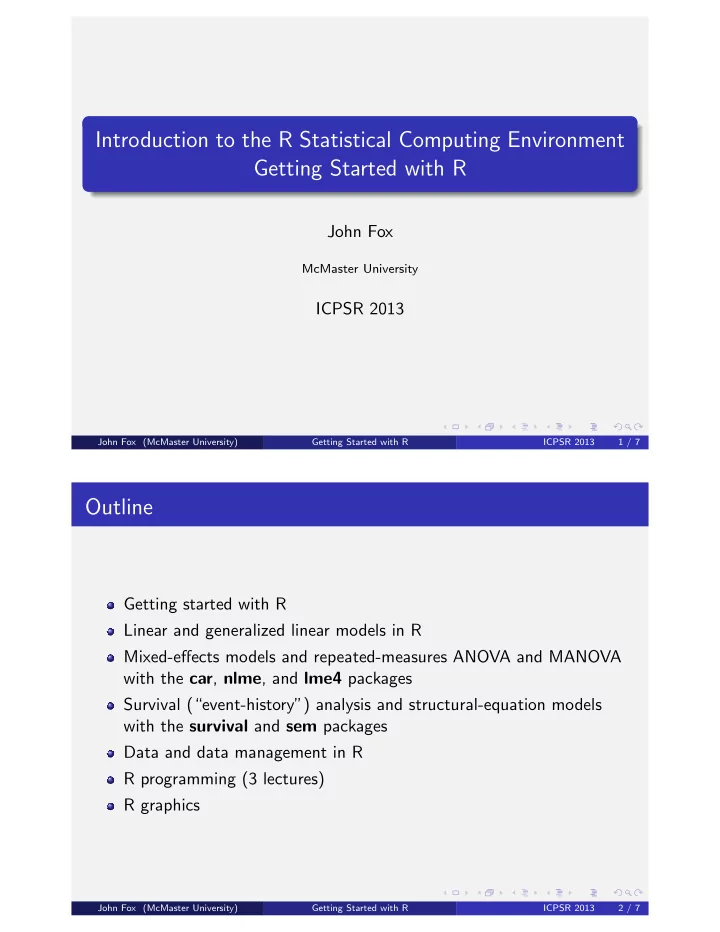

Introduction to the R Statistical Computing Environment Getting Started with R John Fox McMaster University ICPSR 2013 John Fox (McMaster University) Getting Started with R ICPSR 2013 1 / 7 Outline Getting started with R Linear and generalized linear models in R Mixed-effects models and repeated-measures ANOVA and MANOVA with the car , nlme , and lme4 packages Survival (“event-history”) analysis and structural-equation models with the survival and sem packages Data and data management in R R programming (3 lectures) R graphics John Fox (McMaster University) Getting Started with R ICPSR 2013 2 / 7
Getting Started With R What is R? A statistical programming language and computing environment, implementing the S language. Two implementations of S: S-PLUS: commercial, for Windows and (some) Unix/Linux, eclipsed by R. R: free, open-source, for Windows, Macintoshes, and (most) Unix/Linux. John Fox (McMaster University) Getting Started with R ICPSR 2013 3 / 7 Getting Started With R What is R? How does a statistical programming environment differ from a statistical package (such as SPSS)? A package is oriented toward combining instructions and rectangular datasets to produce (voluminous) printouts and graphs. Routine, standard data analysis is easy; innovation or nonstandard analysis is hard or impossible. A programming environment is oriented toward transforming one data structure into another. Programming environments such as R are extensible . Standard data analysis is easy, but so are innovation and nonstandard analysis. John Fox (McMaster University) Getting Started with R ICPSR 2013 4 / 7
Getting Started With R Why Use R? Among statisticians, R has become the de-facto standard language for creating statistical software. Consequently, new statistical methods are often first implemented in R. There is a great deal of built-in statistical functionality in R, and many (literally thousands of) add-on packages available that extend the basic functionality. R creates fine statistical graphs with relatively little effort. The R language is very well designed and finely tuned for writing statistical applications. (Much) R software is of very high quality. R is easy to use (for a programming language). R is free (in both of senses: costless and distributed under the Free Software Foundation’s GPL). John Fox (McMaster University) Getting Started with R ICPSR 2013 5 / 7 Getting Started With R This Lecture Series The purpose of this lecture series is to get participants started using R. The statistical content is largely assumed known. Much of the lecture series is based on J. Fox and S. Weisberg, An R Companion to Applied Regression, Second Edition , Sage (2011). More advanced participants may prefer to read, or want to read in addition, W. N. Venables and B. D. Ripley, Modern Applied Statistics with S, Fourth Edition . New York: Springer, 2002 Additional materials and links are available on the web site for the book: http://socserv.socsci.mcmaster.ca/jfox/Books/Companion/index.html or tinyurl.com/carbook The book is associated with an R package (called car ) that implements a variety of methods helpful for analyzing data with linear and generalized linear models. John Fox (McMaster University) Getting Started with R ICPSR 2013 6 / 7
Getting Started With R This Lecture Series Other references are given on the lecture series web site. Lecture series web site: http://socserv.socsci.mcmaster.ca/jfox/Courses/R/ICPSR/index.html or tinyurl.com/ICPSR-R-course mirrored at tinyurl.com/ICPSR-R-lectures John Fox (McMaster University) Getting Started with R ICPSR 2013 7 / 7
Recommend
More recommend